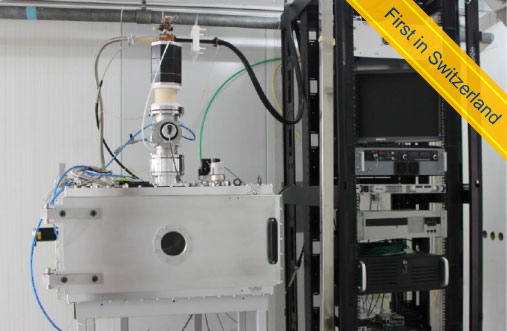Surface treatment by ion implantation (hardion™)

Lifetime of mechanical parts can be significantly increased thanks to hardion™ by idonus,
an innovative technology that performs surface treatment by ion implantation. Our process enables the
hardening of parts, it can also significantly improve metal resistance to corrosion, decrease friction
losses, or tune the hydrophilicity of glass, to give only a few benefits. Countless applications can
now be envisioned at a competitive cost for a wide range of materials.
Our technology and installation are perfectly suited for the treatment of small and medium-sized parts
like those found in mechanical wristwatches or in medical implants.
God created the bulk, and the devil its surface.*
— Wolfgang Pauli
[Nobel Prize in Physics 1945]
* Gott schuf das Volumen, der Teufel die Oberfläche.
The nature and characteristics of an object surface are of equal importance with respect to its bulk properties.
This statement becomes obvious when one thinks, for instance, of wear or corrosion.
Whether for functional or for esthetic purpose, surface treatment is of prior concern and a crucial step in the
fabrication of industrial parts.
Downloads
Ion implantation: Download our flyer on surface treatment
(
PDF).
Features and benefits
Surface modification based on ion implantation, hardion™, is a disruptive technology that enhances the physical and chemical properties of solid parts.
Ion implantation is a cold process, where the underlying phenomena take place at the atomic scale and involve a wide variety of effects
(e.g., nano-hammering, nano-structuring, densification, texturing, re-alloying, amorphization, reticulation, …).
To give some examples among the most sought-after effects, ion implantation can be used to increase surface hardness, reduce friction losses, limit wear,
improve corrosion resistance, or modify the optical characteristics of materials.

- Applications: tribology (wear, friction), corrosion, electronics (conductivity enhancement), biomedical (biocompatible implants),
optics, decorative coloring, …
- Processable parts:
- Applicable for most materials: Particularly suitable for metals (titanium alloys, tungsten carbide, steel,
stainless steel, aluminum, gold, brass and other copper alloys, …) polymers/elastomers (PTFE, PEEK, PMMA, Viton®, …),
and silicon
- 2D or 3D – Plates or three-dimensional objects are mounted on a motorized stage
- Miniature or medium-sized components (e.g., wristwatch parts, machining cutting tools)
- Implantation gases: We work with safe and environment-friendly gases. Namely, implanted atomic species are nitrogen (N),
oxygen (O), carbon (C), hydrogen (H), helium (He), and argon (Ar).
Case study
Ion implantation is particularly suitable for the hardening of sharp edges,
and can be envisioned either as a subsitute or in combination with conventional coating. Hardion™ nitriding of tungsten carbide
significantly increases wear resistance of cutting tools. The benefits go beyond the extended lifetime of treated tools,
since resulting productivity gains can become substantial.
Our offer
We propose two types of solutions depending on your production needs:
- Subcontracting services for surface treatment of semi-finished parts for small series production.
Our technical services include processing, process optimization, material characterization, …
- Equipment design and manufacturing: We develop customized and industrialized turnkey machine.
Our team will adapt the associated fabrication processes to your needs, perform on-site installation, and train your team.

idonus' hardion™ implantation equipment
This implantation machine is a fully functional prototype installed in our workshop (Hauterive, Switzerland).
It is dedicated to R&D projects and to subcontracting services.
|
Useful references
"Assessment of the Functional Properties of 316L Steel Alloy Subjected to Ion Implantation Used in Biotribological Systems,"
K. Piotrowska,M. Madej and D. Ozimina,
Materials, 2021, 14 (19), 5525.
DOI: 10.3390/ma14195525
"Improved Tribological Properties of Brass through Multi Charge Ion-implantation,"
K. Vaideeswaran, O. Sereda, C. Yamahata, S. Biselli, C. Spoerl, M. Dadras, CSEM Scientific and Technical Report, 2019.
"Multi-charged Ion Implantation of Nitrogen for Improved Tribological Properties of Miniaturized Mechanisms,"
K. Vaideeswaran et al., April 2018, CSEM Scientific and Technical Report.
DOI: 10.13140/RG.2.2.19524.76165
"Surface Properties Improvement of Biocompatible Materials by Multi-charged Ion Implantation,"
A. Alan Böhlen et al., April 2018, CSEM Scientific and Technical Report.
DOI: 10.13140/RG.2.2.32946.53446
Technology in a nutshell
The substrate subjected to an ion beam is modified internally — Unlike coatings, which consist in depositing a
thin layer of material on top of a surface, ion implantation modifies the treated parts beneath their surface thanks to
atomic rearrangement of material.
The CERN in small — We use an Electron Cyclotron Resonance (ECR) ion source to produce a positively charged ion beam.
The ECR ion source was invented in the '70s by Richard Geller at CEA (Commissariat à l'Energie Atomique, France).
The technolgy has since undergone tremendous improvements and ECR ion sources are now known to be the most efficient for producing
multi-charged ion beams. At CERN, LINAC3 (3rd generation linear accelerator) is the starting point for ions used in physics experiments.
In this cutting edge installation, one can find an ECR ion source which is used to accelerate heavy lead ions.
Our ECR ion source is a miniaturized version of that system, but its working principle is identical.
Treatment process — The parts to be processed are mounted on a motorized stage, inside a high vacuum chamber, in direct line of sight of the ion beam.
Using active cooling, we ensure that the parts remain below 100 °C during the entire process. With energy levels of the order of hundred keV,
positively charged ions are accelerated towards the parts and penetrate through their surface. The penetration depth is typically in the range of
micrometer (1 μm), while its effects extend far beyond the implantation depth.

Working principle of ion implantation
Our surface treatment equipment is based on Electron Cyclotron Resonance (ECR) technology.
Positively charged ions with multiple energy levels penetrate inside the treated parts and modify
their physical and chemical properties.
|




